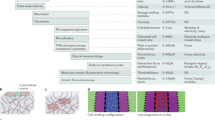Abstract
The complex interactions occurring at the blood/material interface of implanted blood-contacting biomaterials largely determine the clinical efficacy of small diameter vascular grafts. Physical characteristics of the material such as chemical composition, electrical charge, surface texture, elastic modulus, and porosity all affect many responses at the interfaces with blood, surrounding tissues, and adjacent artery. Some responses begin instantaneously (deposition of plasma proteins and platelets) while other reactions are somewhat delayed (deposition of leukocytes and monocytes, and migration of endothelial cells and smooth muscle cells). Each of these elements may become activated and release bioactive substances which further affect the behavior of the other entities in this complex and dynamic microenvironment. It is precisely these tissue reactions that regulate thrombogenicity and the development of pseudointimal hyperplasia.
Similar content being viewed by others
References
ANDRADE JD, HLADY V. Plasma protein adsorption: the big twelve.Ann NY Acad Sci 1987;516:158–172.
VROMAN L. What time does the next protein arrive?Trans Soc Biomater 1986;9:59.
SHEPARD AD, GELFAND JA, CALLOW AD, O'DONNELL TF Jr. Complement activation by synthetic vascular prostheses.J Vasc Surg 1984;1:829–838.
LACKIE JM, DeBONO D. Interactions of neutrophil granulocytes and endothelium in vitro.Microvasc Res 1977;13:107–112.
DEUEL TF, SENIOR RM, HUANG JS, GRIFFIN GL. Chemotaxis of monocytes and neutrophils to platelet-derived growth factor.J Clin Invest 1982;69:1046–1049.
FOX PL, DICORLETO PE. Regulation of production of a platelet-derived growth factor-like protein by cultured bovine aortic endothelial cells.J Cell Physiol 1984;121:298–308.
CLOWES AW, KIRKMAN TR, CLOWES MM. Mechanisms of arterial graft failure. II. Chronic endothelial and smooth muscle cell proliferation in healing polytetrafluoroethylene prostheses.J Vasc Surg 1986;3:877–884.
GREISLER HP, DENNIS JW, ENDEAN ED, ELLINGER J, FRIESEL R, BURGESS WH. Macrophage/biomaterial interaction: the stimulation of endothelialization.J Vasc Surg 1989;9:588–593.
GREISLER HP. Small diameter vascular prostheses: macrophage-biomaterial interactions with bioresorbable vascular prostheses.Trans ASAIO 1988;XXXIV:1051–1059.
GREISLER HP. Pharmacology of the arterial wall. In: WHITE RA (ed). Atherosclerosis: Human pathology and experimental methods and models. Boca Raton; CRC Press, 1989, pp. 111–150.
CLOWES AW, KIRKMAN TR, REIDY MA. Mechanisms of arterial graft healing.Am J Pathol 1986;123:220–230.
GREISLER HP, ELLINGER J, SCHWARCZ TH, GOLAN J, RAYMOND RM, KIM DU. Arterial regeneration over polydioxanone prostheses in the rabbit.Arch Surg 1987;122:715–721.
GREISLER HP, DENNIS JW, ENDEAN ED, KIM DU. Derivation of neointima of vascular grafts.Circulation 1988;78(Suppl I):I6-I12.
DAVIES PF, REMUZZI A, GORDON EJ, DEWEY CR Jr, GIMBRONE MA Jr. Turbulent fluid shear stress induces vascular endothelial cell turnover in vitro.Proc Nat Acad Sci USA 1986;83:2114–2117.
DAVIES PF, DEWEY CR Jr, BUSSOLARI SR, GORDON EJ, GIMBRONE MA Jr. Influence of hemodynamic forces on vascular endothelial function. In vitro studies of shear stress and pinocytosis in bovine aortic endothelial cells.J Clin Invest 1984;73:1121–1129.
FRANGOS JA, MCINTIRE LV, ESKIN SG, IVES CL. Flow effects on prostacyclin production by cultured human endothelial cells.Science 1985;227:1477–1479.
LEUNG DYM, GLAGOV S, MATHEWS MB. Cyclic stretching stimulates synthesis of matrix components by arterial smooth muscle cells in vitro.Science 1976;191:475–477.
BERK BC, ALEXANDER RW, BROCK TA, GIMBRONE MA Jr, WEBB RC. Vasoconstriction: a new activity for platelet-derived growth factor.Science 1986;232:87–90.
HELDIN C-H, RONNSTRAND L. Characterization of the receptor for platelet derived growth factor on human fibroblasts: demonstration of an intimate relationship with a 185,000-dalton substrate for the platelet-derived growth factor-stimulated kinase.J Biol Chem 1983;258:10054–10061.
SHIMOKADO K, RAINES EW, MADTES DK, BARRETT TB, BENDITT EP, ROSS R. A significant part of macrophage-derived growth factor consists of at least two forms of PDGF.Cell 1985;43:277–286.
SCHMIDT JA, MIZEL SB, COHEN D, GREEN I. Interleukin 1, a potential regulator of fibroblast proliferation.J Immunol 1982;128:2177–2182.
RAINES EW, DOWER SK, ROSS R. Interleukin-1 mitogenic activity for fibroblasts and smooth muscle cells is due to PDGF-AA.Science 1989;243:393–396.
BAIRD A, MORMEDE P, BOHLEN P. Immunoreactive fibroblast growth factor in cells of peritoneal exudate suggests its identity with macrophage-derived growth factor.Biochem Biophys Res Commun 1985;126:358–364.
GREISLER HP. Arterial regeneration over absorbable prostheses.Arch Surg 1982;117:1425–1431.
GREISLER HP, ELLINGER J, SCHWARCZ TH, GOLAN J, RAYMOND RM, KIM DU. Arterial regeneration over polydioxanone prostheses in the rabbit.Arch Surg 1987;122:715–721.
GREISLER HP, ENDEAN ED, KLOSAK JJ, ELLINGER J, DENNIS JW, BUTTLE K, KIM DU. Polyglactin 910/polydioxanone bicomponent totally resorbable vascular prostheses.J Vasc Surg 1988;7:697–705.
DICORLETO PE, BOWEN-POPE DF. Cultured endothelial cells produce a platelet derived growth factor-like protein.Proc Natl Acad Sci USA 1983;80:1919–1923.
FOX PL, DICORLETO PE. Acetylated low density lipoprotein suppresses production of platelet-derived growth factor by cultured endothelial cells.J Cell Biol 1985;101:107a.
CASTELLOT JJ Jr, ADDONIZIO ML, ROSENBERG R, KARNOVSKY MJ. Cultured endothelial cells produce a heparin-like inhibitor of smooth muscle cell growth.J Cell Biol 1981;90:372–379.
Author information
Authors and Affiliations
Additional information
Section Editor—Bruce Gewertz, MD, (Chicago, Illinois)
About this article
Cite this article
Greisler, H.P. Interactions at the blood/material interface. Annals of Vascular Surgery 4, 98–103 (1990). https://doi.org/10.1007/BF02042699
Issue Date:
DOI: https://doi.org/10.1007/BF02042699




